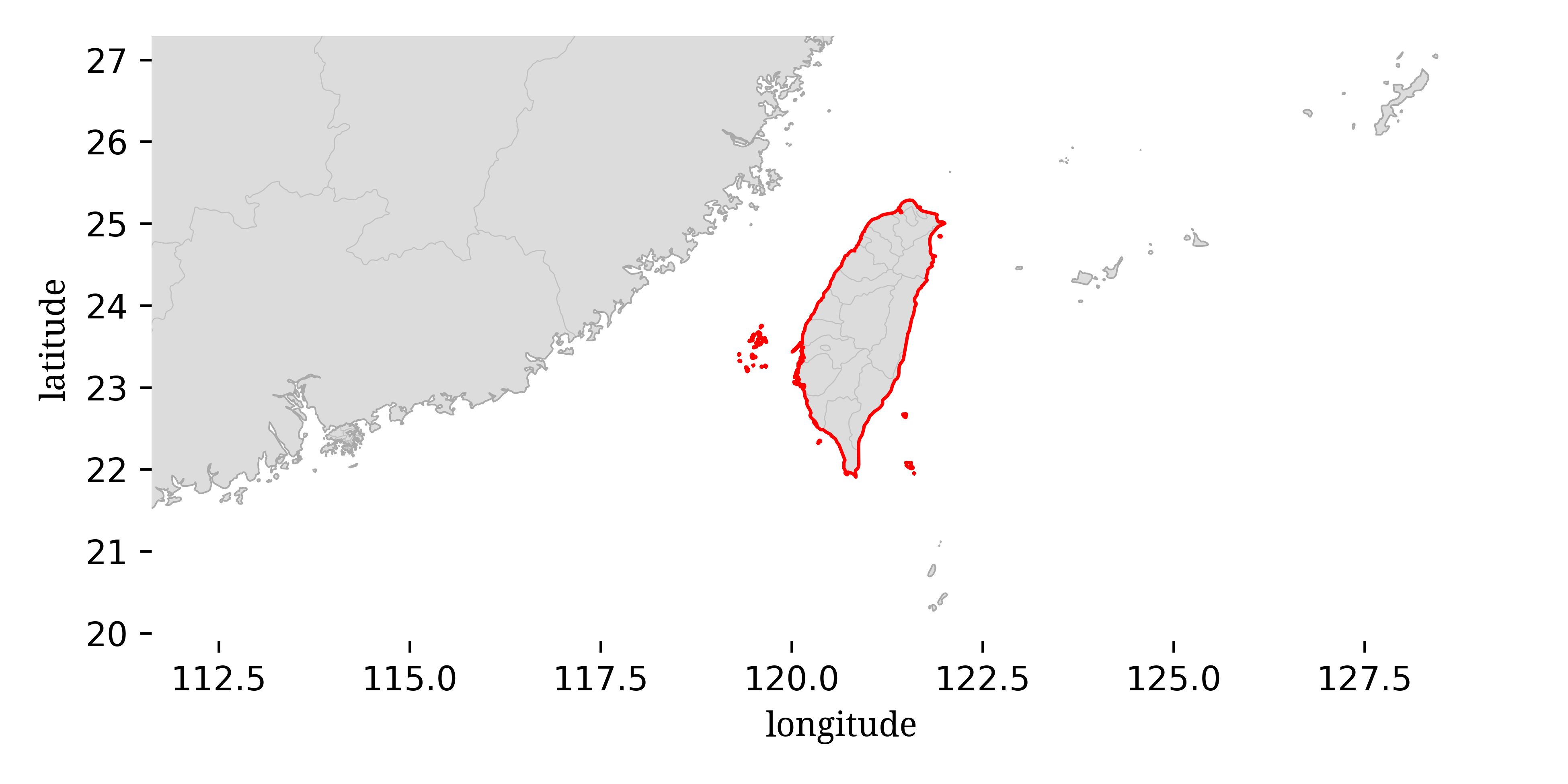
This guide is designed for identification “in the field” where you might be looking at live crabs by eye or through binoculars or from photographs. I will generally try to avoid characters that will require you to physically catch the crab, although I may mention a few for secondary verification. It does not include the more strict taxonomist-style characters that may only be visible under a microscope or via dissection. It is also assumed that the individuals are living, as death (and even capture) can cause dramatic color change.

This is a guide to the fiddler crabs of Taiwan (other than the island of Kinmen, which is very close to the coast of mainland China and is included in that guide), which includes 13 species:
Austruca lactea, Gelasimus borealis, Tubuca arcuata, and Xeruca formosensis and found more-or-less throughout Taiwan while the other species are predominantly only found on the southern (and in particular, the southwestern) coastline, with only occasional occurrences further north.
A number of features can be used to distinguish among these species, but a good place to start is to look at the distance between the base of the eyestalks. Fiddler crabs tend to split into two groups, those with the eyestalks very close together (“narrow front”) and those with the eyestalks separated a bit more (“broad front”). Five of these species (Austruca lactea, Austruca perplexa, Austruca triangularis, Paraleptuca crassipes, and Paraleptuca splendida) are broad front species, while the other eight (Gelasimus borealis, Gelasimus jocelynae, Gelasimus tetragonon, Gelasimus vocans, Tubuca arcuata, Tubuca coarctata, Tubuca dussumieri, and Xeruca formosensis) are narrow front species. Note that the carapace between the eyestalks appears pinched together in the narrow front species, but more trapezoidal in the broad front species.
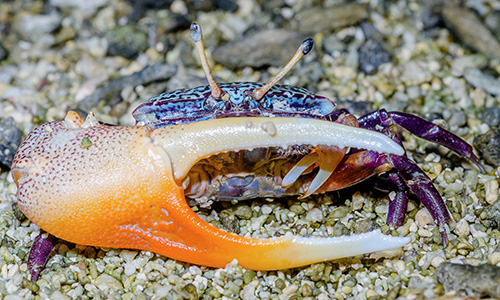
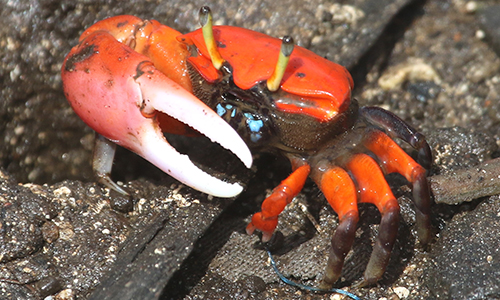
Austruca lactea is one of the more common species in Taiwan, being generally found across the entire island shoreline.
The carapace of Austruca lactea is generally either white or white with black (dark brown) markings, generally a small scattered speckling of black, frequently with a few thin stripes (kind of like a Rorschach test). In rare occasions the carapace will be more black than white. The legs are generally either white or red (ranging from dark to bright). Eyestalks are generally white or gray. The major cheliped is generally entirely white, or with yellow extending from the arm up into the hand of the claw, but usually still white along the fingers.
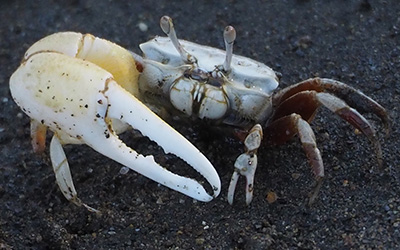

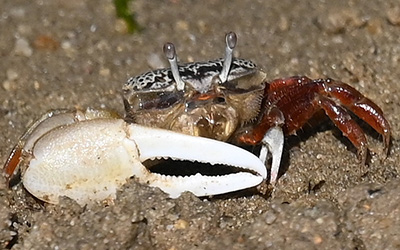
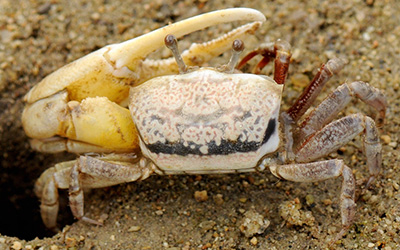

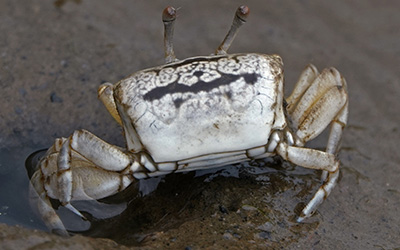
While Austruca lactea is more common among on Taiwan, Austruca perplexa can be readily confused with Austruca lactea when it does occur as they can be very similar in appearance. Within Taiwan, Austruca perplexa is mostly known from the southwestern shore of the island, with only sporadic observations in the north
Austruca perplexa is primarily distinguishable from Austruca lactea by differences in the pattern of the carapace (as well as some very subtle shape differences). Both species have a carapace that is generally black and white. Austruca lactea tends toward having a claw that is mostly white, while Austruca perplexa frequently has a claw that is mostly yellow, but both species can have solid white claws. Austruca lactea will often have dark red legs, while Austruca perplexa rarely does.
The pattern of the black and white pattern on the carapace of the two species has a somewhat subtle difference. Austruca perplexa tends to appear to be more striped, with large, moderately distinct black and white bands, while Austruca lactea tends to be more marbled, without the banding and less distinct boundaries between the colors. On average, Austruca lactea tends toward more white (frequently solid white), while Austruca perplexa tends toward more black (almost never entirely so), but this is not a universal pattern and there is overlap with both species occasionally having entirely white or mostly black carapaces.
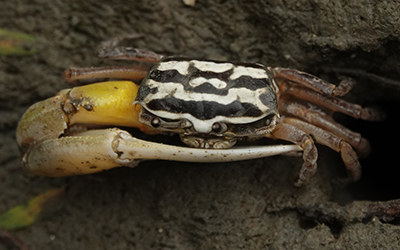

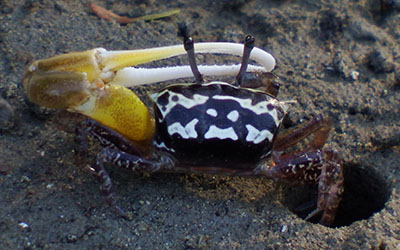
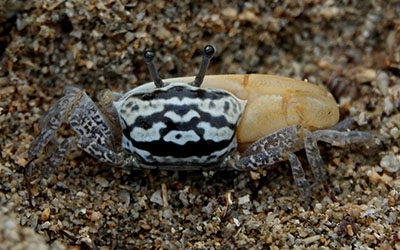
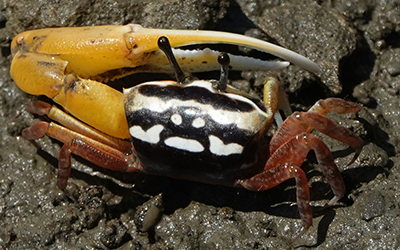
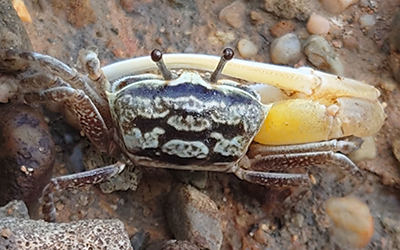
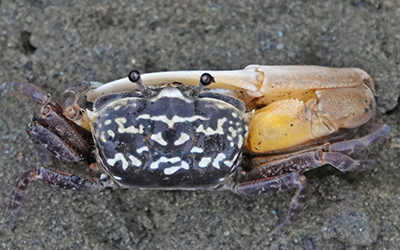
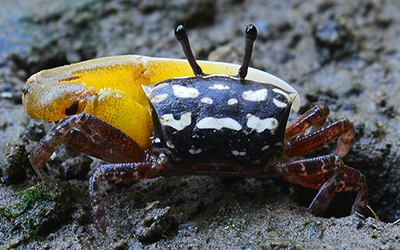
Another subtle difference is in the shape of the front corners of the carapace when seen from above (technically referred to as the anterolateral angles). These corners of the carapace are pointier (the angle is more acute) in Austruca perplexa than Austruca lactea. Compare the apparent sharpness of the front corners of the carapace in the above photos of Austruca perplexa to the more dull corners of Austruca lactea in the set below.
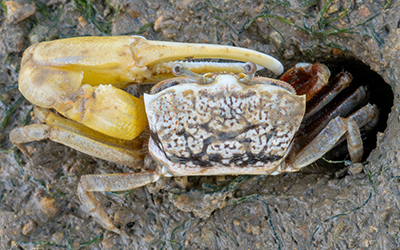
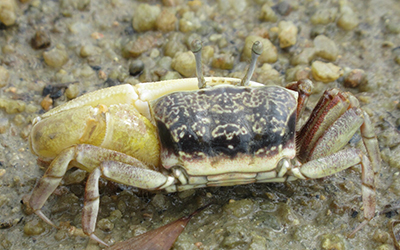
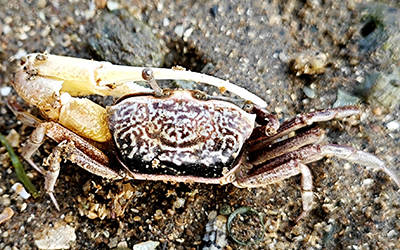
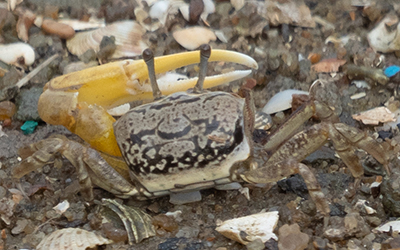
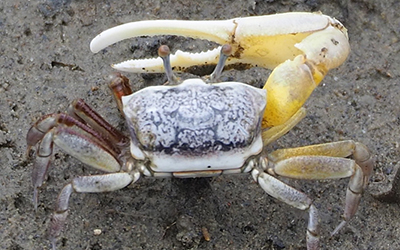
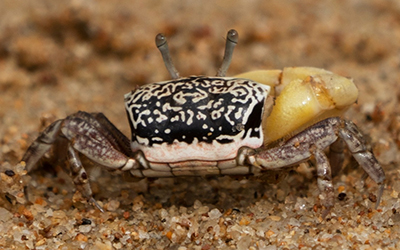
Within Taiwan, Austruca triangularis is only known from the southern part of the island, particularly the southwestern shoreline.
Austruca triangularis is superficially similar in color to both Austruca lactea and Austruca perplexa, generally having a black/brow and white/cream carapace (occasionally yellow), frequently will broad stripes, and a claw which tends to be off white, but may include yellow. Despite this general similarity, the species should be relatively easy to tell apart.
There are at least three features which can be used to distinguish them. First, the carapace shape is noticably different, with the front corners of the carapace of Austruca triangularis extremely pointy and tending to point more toward the sides than the front, with the sides of the carapace converging much more strongly in Austruca triangularis than in either Austruca lactea or Austruca perplexa. Second, the hand of the large claw in Austruca triangularis is generally covered with brown spots, giving it a polka-dotted appearance (these spots are sometimes foundon the carapace as well). Third, but more subtle, on average Austruca triangularis tends to be smaller than the other two species, although there is overlap in size.
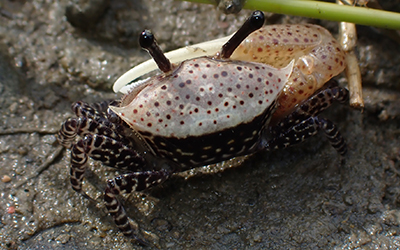
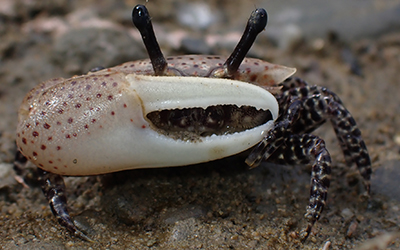
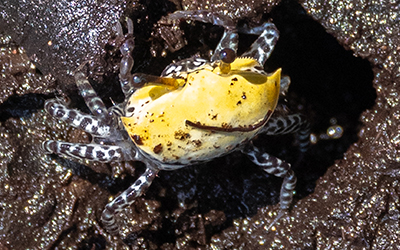
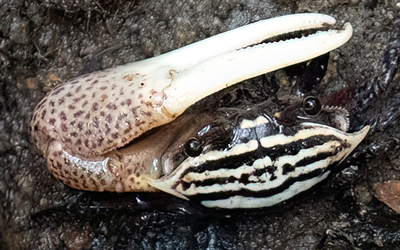
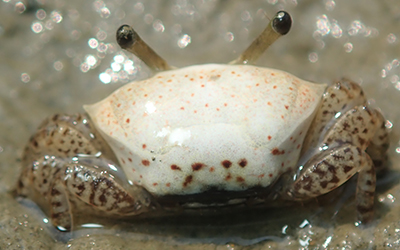
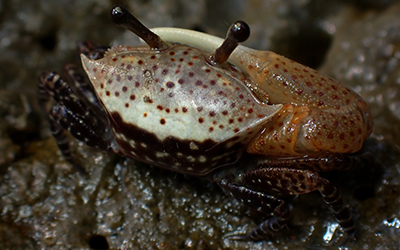

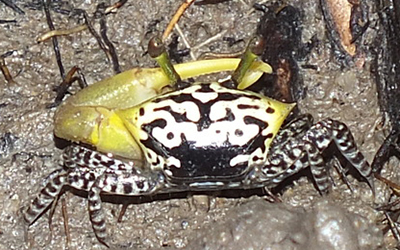
The last two broad front species in Taiwan, Paraleptuca crassipes and Paraleptuca splendida, are very similar to each other, although very different from the other broad front species. The colors of these species also overlap with one of the narrow front species, Tubuca coarctata, described below.
Paraleptuca crassipes is a highly variable species with a carapace that is generally some combiantion of black, pale blue, and bright red—occasionally with a hint of yellow or green—with solid red and all-but-solid black carapaces not uncommon (it seems never to be solid blue). It's eyestalks are usually yellow-green, but sometimes red, particularly in individuals with heavily red carapaces. The large claw is bright red-to-reddish pink, with paler pink or white fingers.
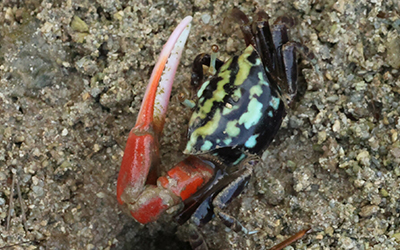
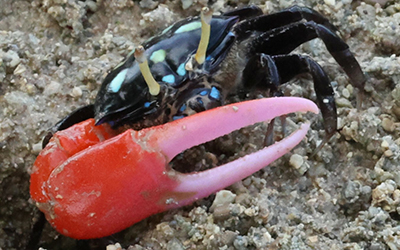
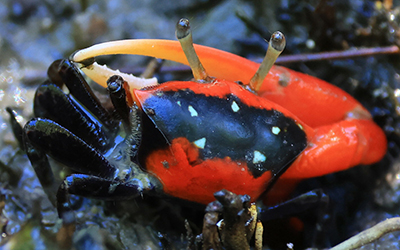
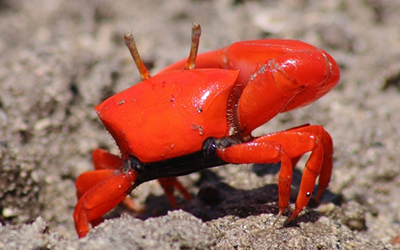
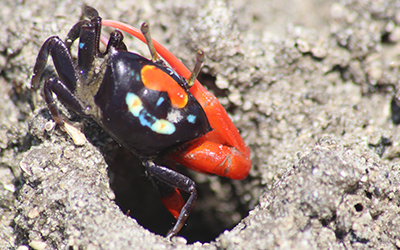
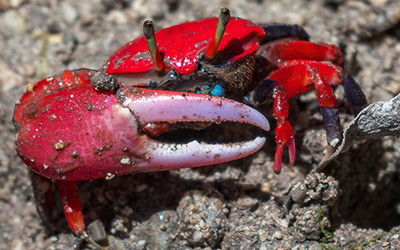
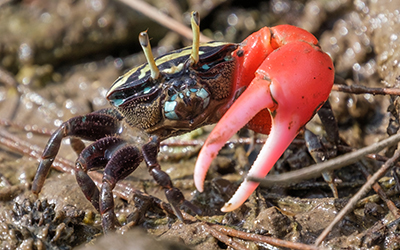

Paraleptuca splendida is very similar to Paraleptuca crassipes, although it lacks the variability of the latter. The carapace is generally a marbled aqua (blue) and black, sometimes with a patch of red behind the eyes; occasionally the blue fades to more of a tan color. Paraleptuca splendida never has the predominantly red carapace that is sometimes found in Paraleptuca crassipes. The legs are usually red (although sometimes more blue/tan/black striped). The major claw of the males is red, with paler pink fingers. Most importantly, the eyestalks are almost always red or red-tinted. By-and-large, the red eyestalks are the primary character used to distinguish between Paraleptuca splendida and Tubuca coarctata.
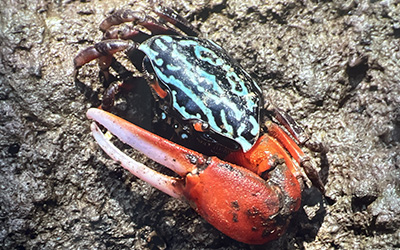
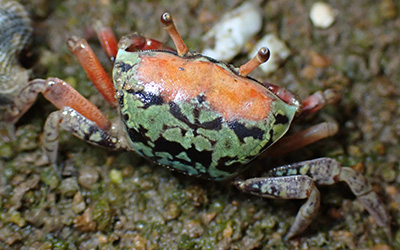
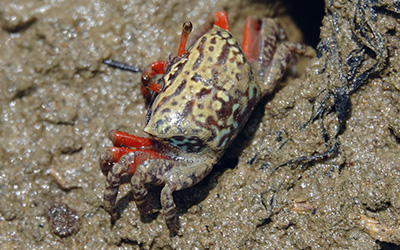
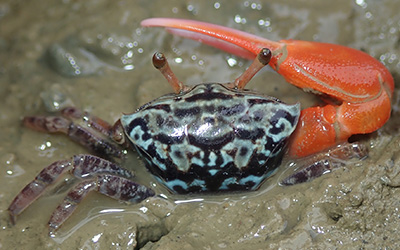
Xeruca formosensis is endemic to Taiwan and one of the easier species to identify. It generally has a solid black or darkly marbled carapace and a mostly white (darker on the hand, usually either gray or a dull orange/pink) large claw with smooth-looking flat fingers. The arm holding the large claw may be red.

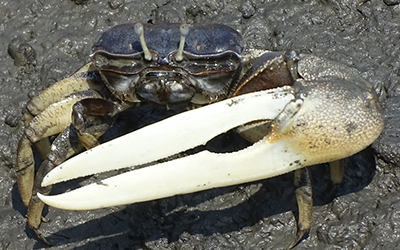
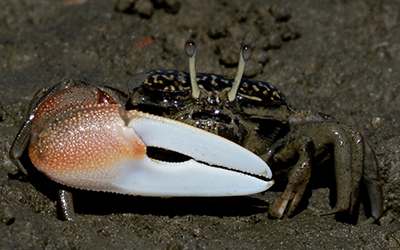
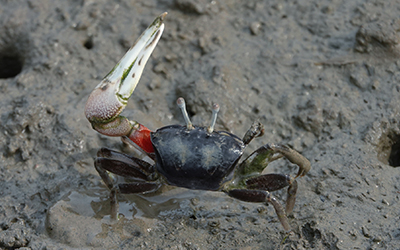
Gelasimus tetragonon is a wide-spread species that is something of an oceanic island specialist, although it is occasionally found on continental shores. It usually has a predominantly blue and black carapace with bright red legs (which occasionally may be darker) and gray eyestalks. The large claw of Gelasimus tetragonon is usually orange, with a noticeably darker red spot near the base of the pollex, and a white dactyl. Gelasimus tetragonon frequently has brown spots on the top part of the hand of the claw.
Gelasimus tetragonon has a lot of additional variability. In some places the carapace can lighten so that there is almost no blue, just a cream or pale orange with black markings. The pattern of the colors on the carapace can vary from stripes or blotches to tiny spots.
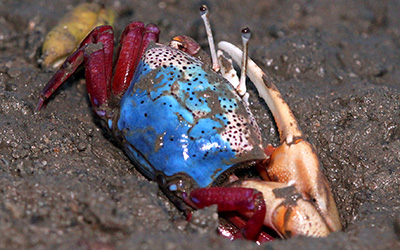
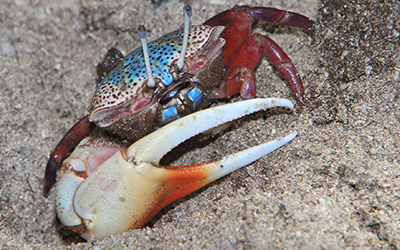
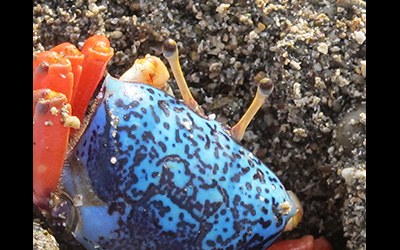
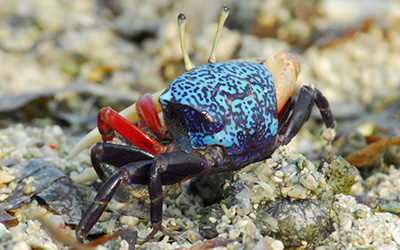
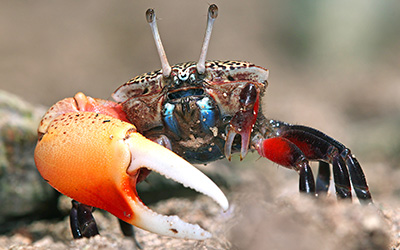
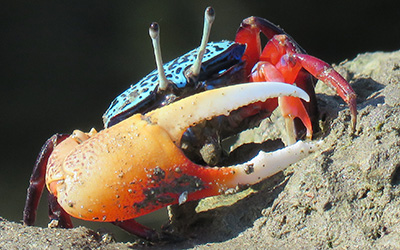
Tubuca arcuata is among the most common fiddler crabs in Taiwan and the northwestern Pacific. The carapace of Tubuca arcuata is usually a mix of white and black, sometimes red and black, although in some individuals it may appear more solid white, black, or red. The black markings tend to be in large patches, often with a large stripe across the middle of the carapace and a second stripe toward the back of the carapace. The black sections will often appear speckled with the background color. In rarer instances, the white may appear more as a pale blue, particularly in juveniles. They generally have yellowish eyestalks with dark eyes.
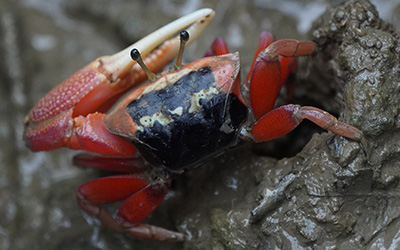

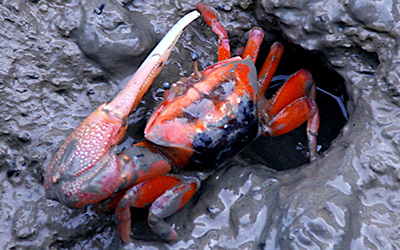

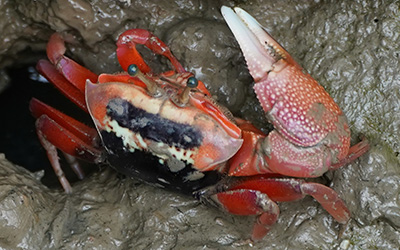
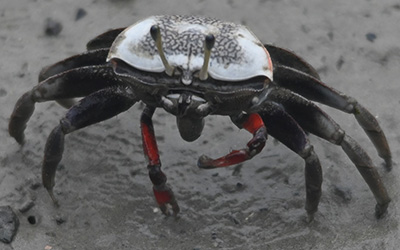
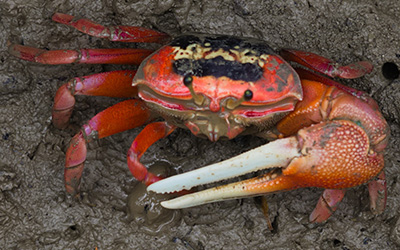
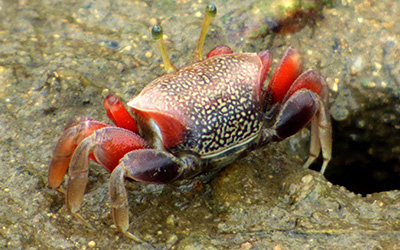
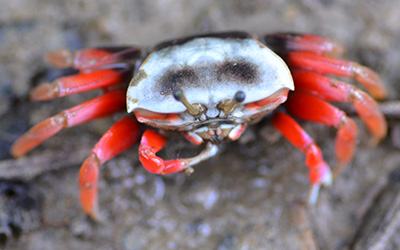
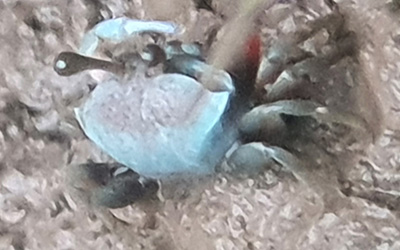
The limbs of Tubuca arcuata are usually red, sometimes black. The large claw is very robust, with distinct bumps on the outside. It is generally red, with white fingers. The fingers are usually distinctly curved and frequently meet with at the tips with flat inner surfaces. There will frequently be a distinct tooth about midway along the lower finger, and occasionally on the upper.
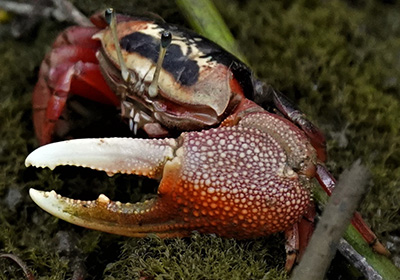
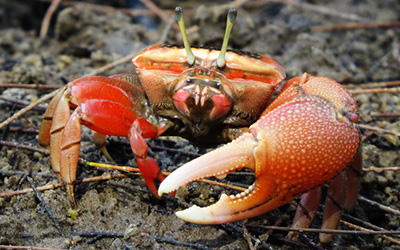
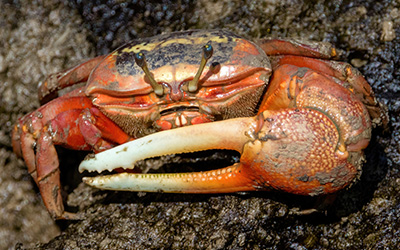
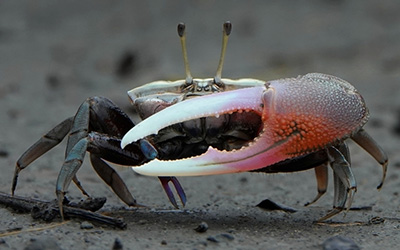
Within Taiwan, Tubuca coarctata is only known from the southern part of the island, particularly the southwestern shoreline.
Tubuca coarctata is a highly variable narrow front species that is most likely to be confused in this region with Tubuca dussumieri or the broad front species Paraleptuca crassipes. Differences between Tubuca coarctata and Tubuca dussumieri will be described below, so this section will focus more on Tubuca coarctata vs Paraleptuca crassipes. On average, front breadth might be the easiest way to distinguish these as the high variaiblity of both species creates a lot of general overlap in color pattern.
The most common carapace pattern in Tubuca coarctata is a mostly black carapace with some spots of pale blue, yellow, red, or white. In many cases, however, individuals may have carapaces that appear nearly solid of any of these colors or consist more of two-toned stripes of two of these colors (the latter pattern might be more common in females than males).
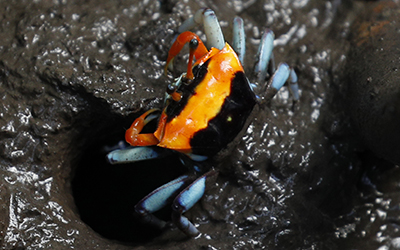

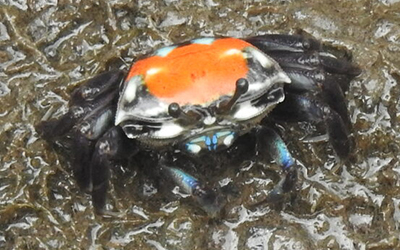
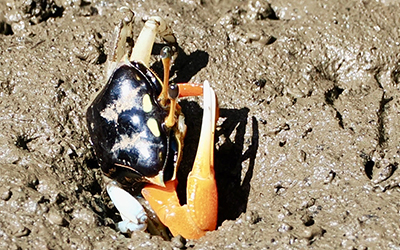
The legs of Tubuca coarctata generally follow this same color variation as the carapace, although the two rear legs generally have a large distinct, pale blue (sometimes almost white) blotch on the rear of the the top segment. This color will sometimes spread beyond this segment.
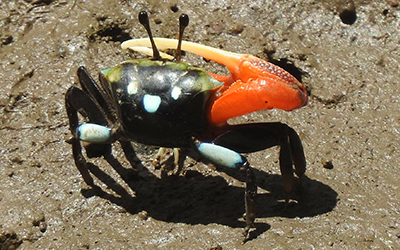
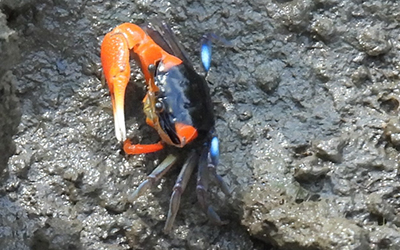

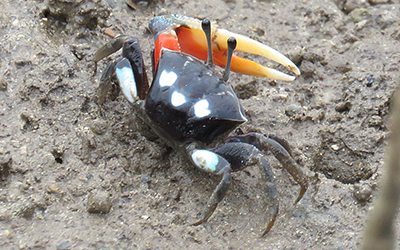
The large claw usually has a red or orange hand, with most of the upper finger and the outer half of the lower finger white. Sometimes the white will bleed further onto the upper part of the hand. There is also usually a darker red patch at the base of the lower finger (as is common in many other species). The prototypical male Tubuca coarctata has a distinct an obvious flat edged projection along the lower portion of the tip of the upper finger of the large claw. In some individuals this feature is more subtle, while other species may have a claw shape that is at least somewhat similar, although within this region this shape is more-or-less unique to this species.
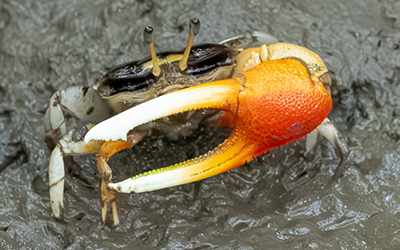

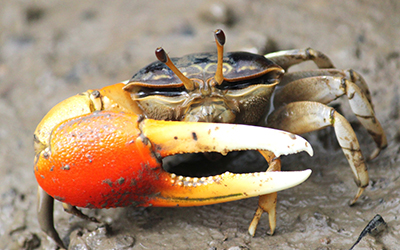

Other than front breadth, the most likely methods of distinguishing Tubuca coarctata from Paraleptuca crassipes are the shape of the tip of the large claw and the presence of the blue spots on the backs of the rear legs. Paraleptuca crassipes also leans much more heavily toward bright reds than Tubuca coarctata, whose redder forms are more orange.
Within Taiwan, Tubuca dussumieri is only known from the southern part of the island, particularly the southwestern shoreline.
Tubuca dussumieri lacks the extreme variability of Tubuca coarctata but overlaps in color. Tubuca dussumieri generally has a dark blue or black carapace, frequently solid colored although some spotting is possible, which can be similar to that found in Tubuca coarctata, including occasional pale spots on the rear legs.
The large claw of male Tubuca dussumieri is generally two-toned, orange on the bottom and white on the top, with a darker orange/red patch at the base of the bottom finger. The fingers of the large claw tend to be fairly straight, and the upper finger lacks the distinct flattened edge that tends to be found in Tubuca coarctata. There may be some flattening of that finger tip in Tubuca dussumieri, but it is more subtle than that of Tubuca coarctata.
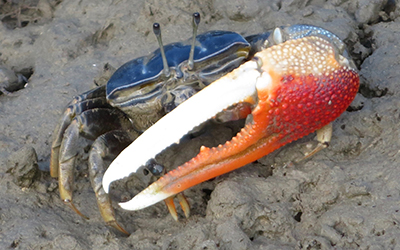
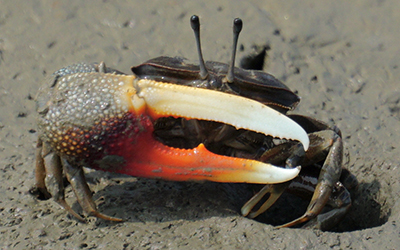
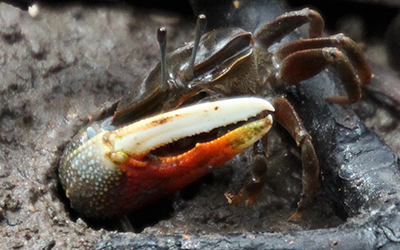
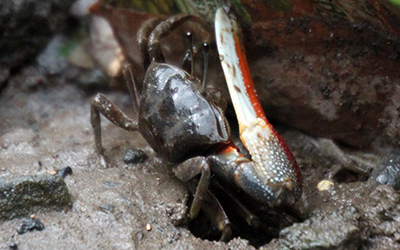
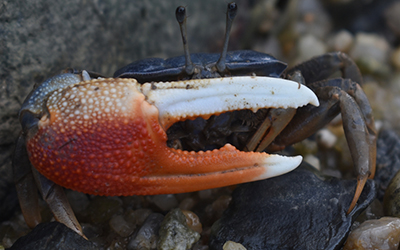
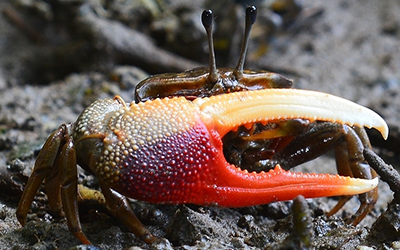
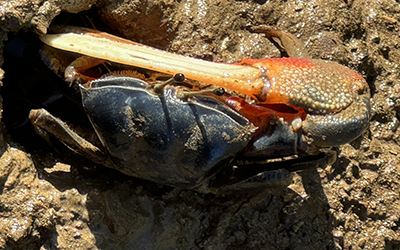
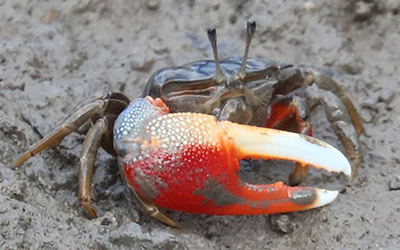
A final feature that distinguishes the two species may be too subtle to see in most cases, but is worth mentioning. Tubuca dussumieri has two long grooves running across most of the length of the upper finger of the large claw; Tubuca coarctata only has one. Unfortunately, these grooves are not always readily visible, particularly as the pale upper fingers of the claw frequently appear slightly overexposed in photographs.

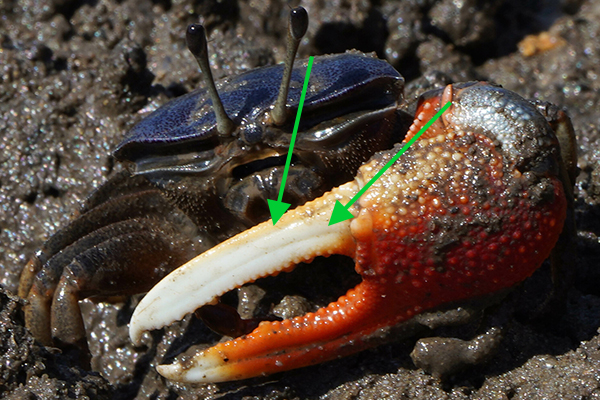
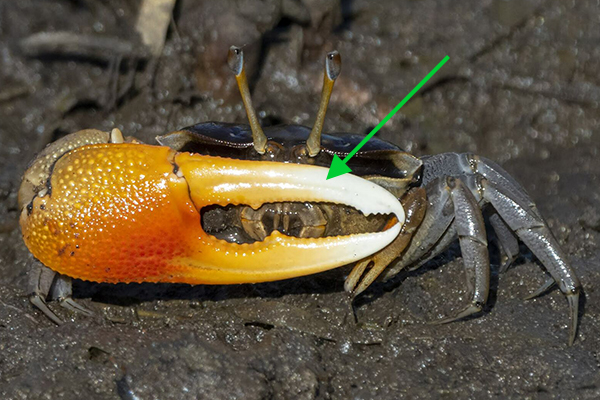
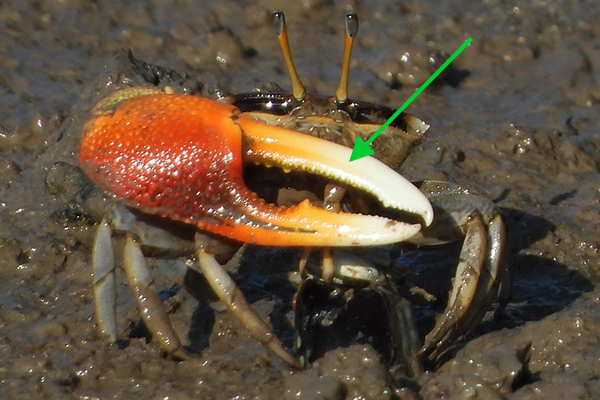
Tubuca paradussumieri is generally not found on the main island of Taiwan (there are a handful of stray observations of it on iNaturalist), although it is common on Kinmen Island close to the continental coast of China. It is similar in general appearance to Tubuca dussumieri but tends to be duller in color and lacks the orange/red on the large claw, instead tending more toward a general beige.
The three species in the Gelasimus (Gelasimus) subgenus are very similar and can be difficult to tell apart. They largely overlap in color (although one tends to be a bit duller than the other two) and by-and-large have very similar forms (although one has a subtle difference in claw shape from the others). Gelasimus borealis is the most common of the three and found over the entire island, while the other two species, Gelasimus jocelynae and Gelasimus vocans, appear to be restricted to the southern coast.
Gelasimus borealis has a distinct claw shape that is only found in the species of this subgenus. Specifically, the upper finger tends to be moderately broad, tapering smoothly to a point, while the lower finger will usually curve upwards with a characteristic wave on the inner surface highlighting one to two large teeth. Individuals with regenerating claws will often lack much of this shape, but the claw still looks readily different from other fiddler crabs.
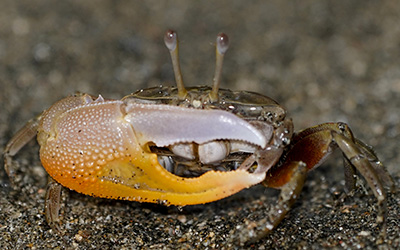
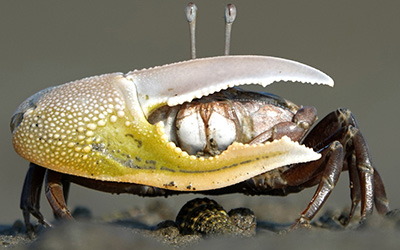
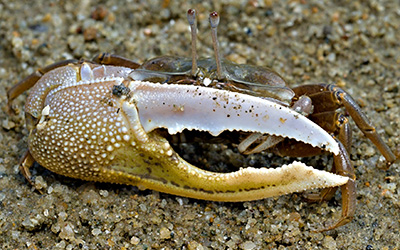
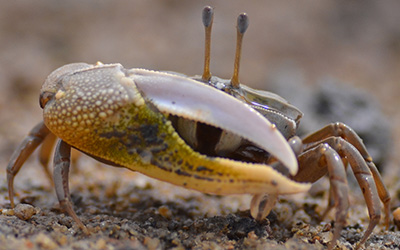
The carapace of Gelasimus borealis is generally solid colored or lightly marbled, rather than with the more dramatic patterns of many other species; the color is frequently green or dark brown or white. The lower finger of the claw is typically yellow-green or orange, with the upper finger white or pink. The species entirely lacks red, alhtough the orange on the claw will sometimes be reddish.
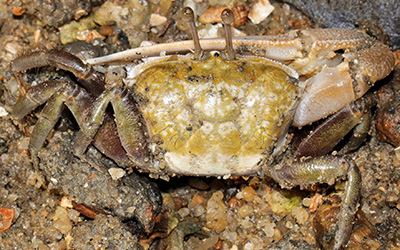
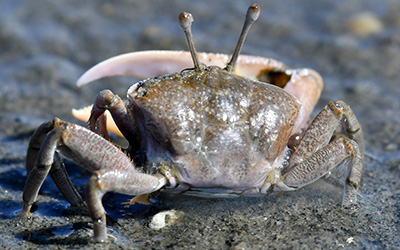
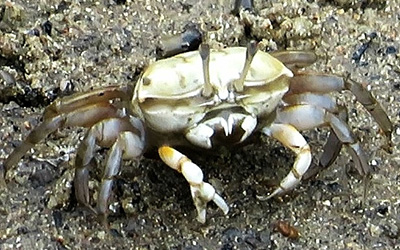
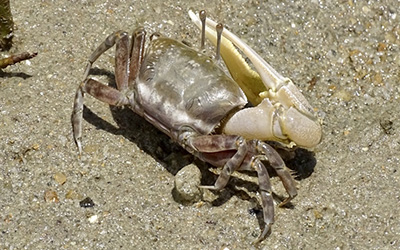
Gelasimus vocans is extremely similar to Gelasimus borealis and can be difficult to distinguish in the field, although there are some subtle indicators. On males of Gelasimus vocans with classic, unregenerated large claws, the tooth pattern on the lower finger is more striking and pronounced that found in Gelasimus borealis, where the teeth are never as striking; unfortunately regenerated claws are more likely to overlap in shape and structure across the two species. Compare more dramatic shape of lower finger of claw on the below photos to the more subtle shape of the previous species.

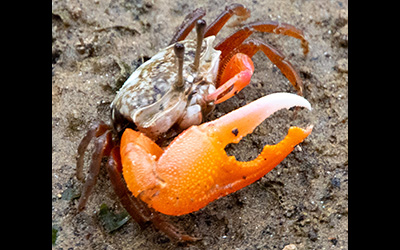

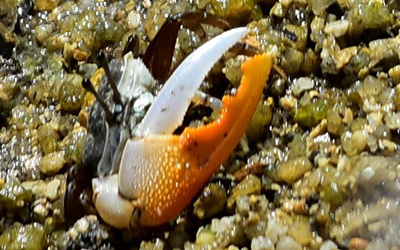
Another subtle difference which can also be seen in the above photos is that the color of Gelasimus borealis tends to be more dull, while that of Gelasimus vocans tends to be more bright and bold. Contrast the shades of orange on the claws of the two species.
A final very subtle difference which is difficult to see in the field and most photos is in the shape of the small claw on males (and both claws of females). In Gelasimus vocans the gap between the fingers of the small claw tends to be as wide or wider than the lower finger, while on Gelasimus borealis this gap tends to be narrower than the lower finger. Compare the gap in the small claws between these two sets of photos.
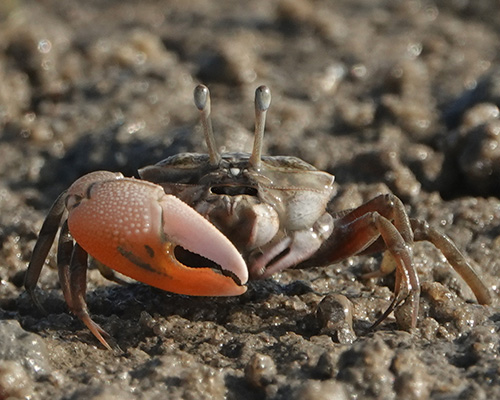

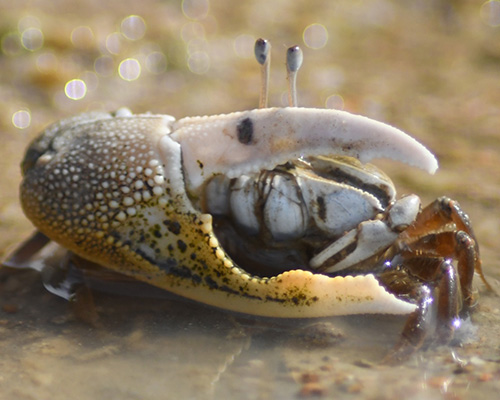

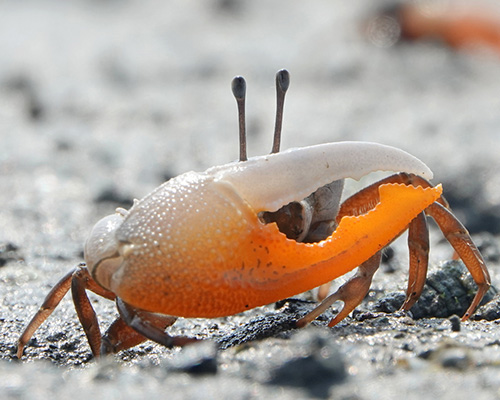
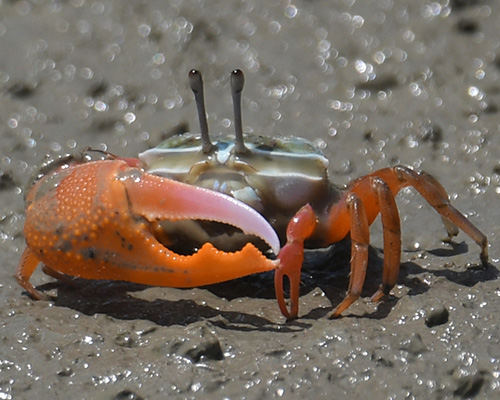
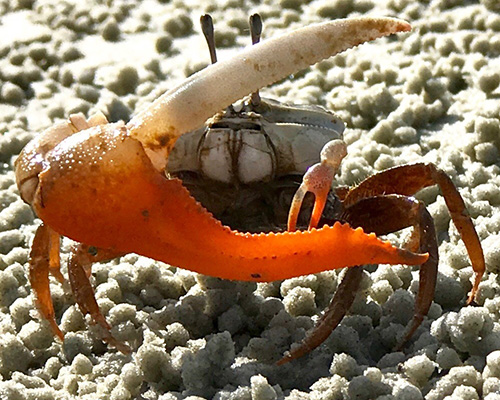
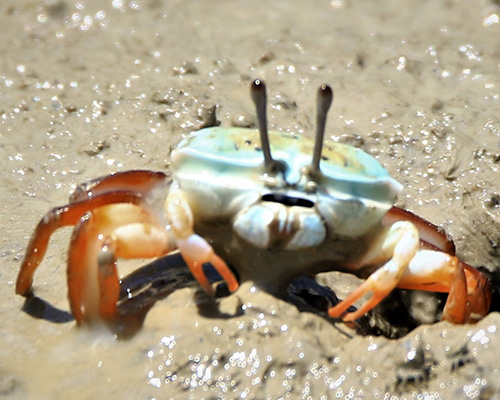
Gelasimus jocelynae is the same basic colors as Gelasimus borealis and Gelasimus vocans, although more along the bright lines of Gelasimus vocans rather than the duller tones of Gelasimus borealis. The primary difference between Gelasimus jocelynae and the other two species is a subtle difference in claw shape. While the general shape and toothiness of the claw is the same, the difference is found in the thickness of the dactyl (upper finger) of the large claw. In Gelasimus jocelynae this finger is thicker than that of the pollex (lower finger) (particularly around the first 1/3-1/2 of the finger), while in the other two species the dactyl is the same width or thinner than the lower finger.
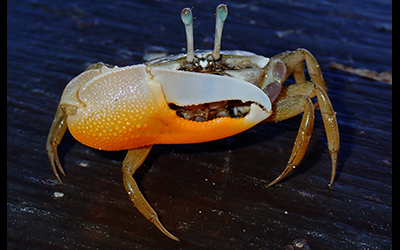
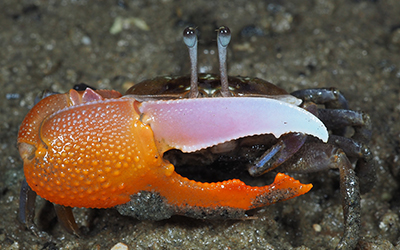
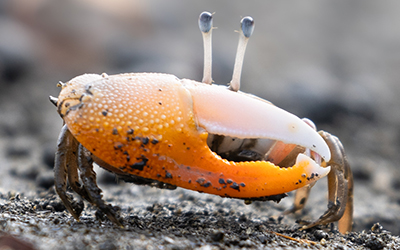
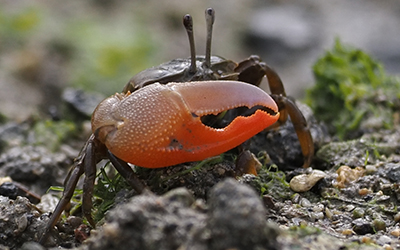
I believe the gape in the small claw of Gelasimus jocelynae is on the narrower side and thus more similar in width to that of Gelasimus borealis, rather than the slightly wider gape found in Gelasimus vocans.